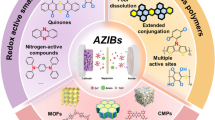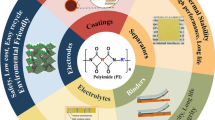Abstract
Poly(2-chloroaniline-co-2-ethylaniline)-composite-Zn was synthesized by in situ chemical oxidative method using ammonium per sulphate as oxidant, HCl as dopant and linear alkyl benzene sulphonic acid (LABSA) as surfactant. The resulting copolymer composite was characterized by FTIR, and UV–Visible spectroscopic methods. The thermal stability was established using thermogravimetric analysis. The conduction mechanism was examined in terms of the dielectric constant and the electrical conductivity of 1.46 × 10–7 Scm−1 measured showed semiconducting nature. The oxidation/reduction potentials and electrochemical reaction of Li/copolymer cells were tested by cyclic voltammetric technique. Poly(2-chloroaniline-co-2-ethylaniline)-composite-Zn has been tested as anode in Li-ion batteries. The discharge and charge capacity of ~ 47 and ~ 14mAh/g at 1 to 5 cycles show good reversibility. This is a feasible value for using it as the positive electrode material in lithium ion secondary batteries.
















Similar content being viewed by others
References
Shirakawa H, Louis EJ, Mac Diarmid AG, Chiang CK, Heeger AJ (1997) Synthesis of electrically conducting organic polymers: halogen derivatives of polyacetylene, (CH)x. Chem Commun 16:578–580
Elsenbaumer RL, Reynolds JR (1998) Handbook of conducting polymers, vol 2, 2nd edn. Marcel Dekker, New York, p 1097
Chandrasekhar P (1999) Conducting polymers, fundamentals and applications: a practical approach, vol 3. Kluwer Academic, Boston, p 760
MacDiarmid AG (2001) “Synthetic metals”: a novel role for organic polymers (Nobel lecture). Angew Chem Int Ed 40(14):2581–2590
Hall N (2003) Rhodium catalysed dehydrogenative borylation of vinylarenes and 1,1-disubstituted alkenes without sacrificial hydrogenation—a route to 1,1-disubstituted vinylboronates. Chem Commun 1:614–615
Sailor MJ, Curtis CL (1994) Conductiong polymer connections for molecular devices. Adv Mater 6:688–692
Zhang J, Manias E, Wilkie CA (2008) Polymerically modified layered silicates: an effective route to nanocomposites. J Nanosci Nanotechnol 8:1597–1615
Shimano JY, MacDiarmid AG (2001) Polyaniline, a dynamic block copolymer: key to attaining its intrinsic conductivity? Synth Met 123:251–262
Michira I, Akinyeye R, Somerset V, Klink MJ, Sekota M, Al-Ahmed A, Baker PGL, Iwuoha EI (2007) Synthesis, characterisation of novel polyaniline nanomaterials and application in amperometric biosensors. Macromol Symp 255:57–69
Wu CS, Huang YJ, Hsieh TH et al (2008) Studies on the conducting nanocomposite prepared by in situ polymerization of aniline monomers in a neat (aqueous) synthetic mica clay. J Polym Sci Part A 46:1800–1809
Lei X, Su Z (2007) Conducting polyaniline‐coated nano silica by in situ chemical oxidative grafting polymerization. Polym Adv Technol 18:472–476
Yang S, Ruckentein E (1993) Processable conductive composites of polyaniline/poly (alkyl methacrylate) prepared via an emulsion method. Synth Met 59:1–12
Ruckenstein E, Yang S (1993) An emulsion pathway to electrically conductive polyaniline-polystyrene composites. Synth Met 53:283–292
Ruckenstein E, Sun Y (1995) Polyaniline-containing electrical conductive composite prepared by two inverted emulsion pathway. Synth Met 74:107–113 [US Patent 5,508,348]
Ghosh P, Chakrabarti A, Siddhanta SK (1999) Studies on stable aqueous polyaniline prepared with the use of polyacrylamide as the water soluble support polymer. Eur Polym J 35:803–813
Park JK (2012) Principles and applications of lithium secondary batteries. Wiley, Hoboken
Vincent CA (2000) Lithium batteries: a 50-year perspective, 1959–2009. Solid State Ion 134:159–167
Guan H, Fan L-Z, Zhang H, Qu X (2010) Polyaniline nanofibers obtained by interfacial polymerization for high-rate supercapacitors. Electrochim Acta 56:964–968
Takamura T, Sumiya K, Suzuki J, Yamada C, Sekine K (1999) Enhancement of Li doping/undoping reaction rate of carbonaceous materials by coating with an evaporated metal film. J Power Sources 368:81–82
Wallace GG, Innis PC, Kane-Maguire LAP (2004) In: Nalwa HS (ed) Encyclopedia of nanoscience and nanotechnology. American Scientific Publishers, Los Angles, vol 4, pp 113–130
Huang WS, Humphrey BD, MacDiarmid AG (1986) Polyaniline, a novel conducting polymer. Morphology and chemistry of its oxidation and reduction in aqueous electrolytes. J Chem Soc Faraday Trans 1 82:2385–2400
Wang Q, Dong X, Pang Z, Yuanzhi Du, Xia X et al (2014) Understanding polymorphism in organic semiconductor thin films through nanoconfinement. J Nanomed Res 12(12):17046–17057
Nigrey PJ, Maclnnes D Jr, Nairns DP, Macdiarmid AJ (1981) Lightweight rechargeable storage batteries using polyacetylene,(CH) x as the cathode‐active material. J Electrochem Soc 128(8):1651
Panero S, Prosperi P, Bonino F, Scrosati B, Corradini A, Mastragostino M (1987) Characteristics of electrochemically synthesized polymer electrodes in lithium cells—III. Polypyrrole. Electrochim Acta 32(7):1007
Hu YS, Demir-Cakan R, Titirici MM, Muller JO, Schlogl R, Antonietti M, Maier J (2008) Superior storage performance of a Si@SiOx/C nanocomposite as anode material for lithium‐Ion batteries. Angew Chem Int Ed 47(9):1645–1649
Liu J, Lin YH, Liang L, Voigt JA, Huber DL, Tian ZR, Coker E, Mckenzie B, Mcdermott MJ (2003) Templateless assembly of molecularly aligned conductive polymer nanowires: a new approach for oriented nanostructures. Chem Eur J 9:605–611
Husang JX, Virji S, Weiller BH, Kaner RB (2003) Polyaniline nanofibers: facile synthesis and chemical sensors. J Am Chem Soc 125:314–315
Wan MX (2004) Journal of nanoscience and nanotechnology. In: Nalwa HS (ed) 2: 153–169. American Scientific Publishers, Los Angeles
Qiu HJ, Wan MX, Mathews B, Dai LM (2001) Conducting polyaniline nanotubes by template-free polymerization. Macromolecules 34:675–681
Husang JX, Kaner RB (2006) The intrinsic nanofibrillar morphology of polyaniline. Chem Commun 4:491–496
Wessling B (1997) Organic metals. Synth Met 85(1–3):1313–1318
Kim HM, Lee CY, Joo JJ (2000) AC dielectric relaxation of lightly hydrochloric-acid (HCl)-doped polyanilines. Korean Phys Soc 36:371
Malathi J et al (2010) Structural, thermal and electrical properties of PVA–LiCF3SO3 polymer electrolyte. J Non-Cryst Solids 356:2277–2281
Suthanthiraraj SA, Vadivel MK (2012) Electrical and structural properties of poly (ethylene oxide)/silver triflate polymer electrolyte system dispersed with MgO nanofillers. Ionics 18:385–394
Hodge IM, Ingram MD, West AR (1976) Impedance and modulus spectroscopy of polycrystalline solid electrolytes. J Electro Anal Chem 74:125–143
Genies EM, Hany P, Santier C (1988) A rechargeable battery of the type polyaniline/propylene carbonate-LiClO 4/Li-Al. J Appl Electrochem 18:751
Aravindan V, Gnanaraj J, Lee YS, Madhavi S (2013) LiMnPO 4–A next generation cathode material for lithium-ion batteries. J Mater Chem A 1:3518–3539
Mirmohseni A, Wallace GG (2003) Preparation and characterization of processable electroactive polyaniline–polyvinyl alcohol composite. Polymer 44:3523–3528
Ryu KS, Kim KM, Kang SG, Lee GJ, Joo SH (2000) Electrochemical and physical characterization of lithium ionic salt doped polyaniline as a polymer electrode of lithium secondary battery. Synth Met 110:213–217
Sumeyye BS, Deniz S, Burak E, Ali EM (2015) A novel cathode material based on polystyrene with pendant TEMPO moieties obtained via click reaction and its use in rechargeable batteries. J Polym Res 22:136
Author information
Authors and Affiliations
Corresponding author
Additional information
Publisher's Note
Springer Nature remains neutral with regard to jurisdictional claims in published maps and institutional affiliations.
Rights and permissions
About this article
Cite this article
Padmaja, S., Samuel, J.M. Chemically copolymerized poly(2-chloroaniline-co-2-ethylaniline)-composite-Zn as an anodic material in Li-ion batteries. Polym. Bull. 78, 5119–5135 (2021). https://doi.org/10.1007/s00289-020-03360-8
Received:
Revised:
Accepted:
Published:
Issue Date:
DOI: https://doi.org/10.1007/s00289-020-03360-8




